人教版(2019)必修第一册Unit 4 Natural Disasters Reading and Thinking 课件(共24张PPT,内嵌视频)
文档属性
| 名称 | 人教版(2019)必修第一册Unit 4 Natural Disasters Reading and Thinking 课件(共24张PPT,内嵌视频) | 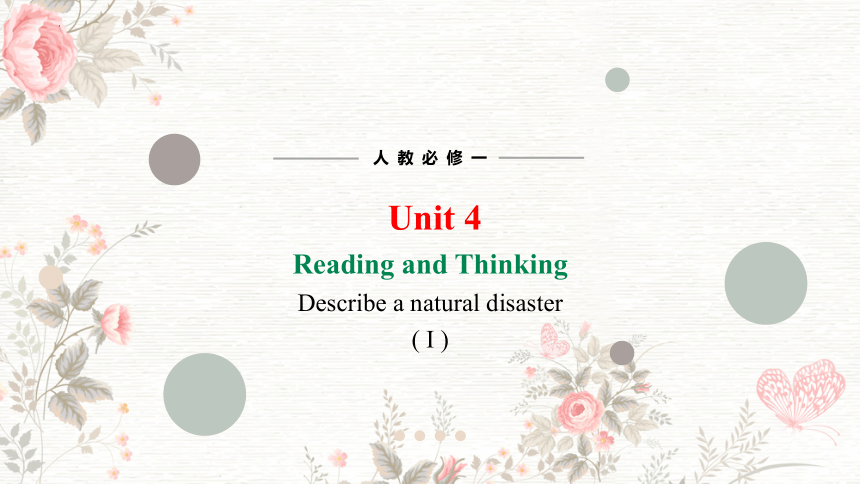 | |
| 格式 | pptx | ||
| 文件大小 | 12.6MB | ||
| 资源类型 | 教案 | ||
| 版本资源 | 人教版(2019) | ||
| 科目 | 英语 | ||
| 更新时间 | 2023-11-29 22:59:03 | ||
图片预览

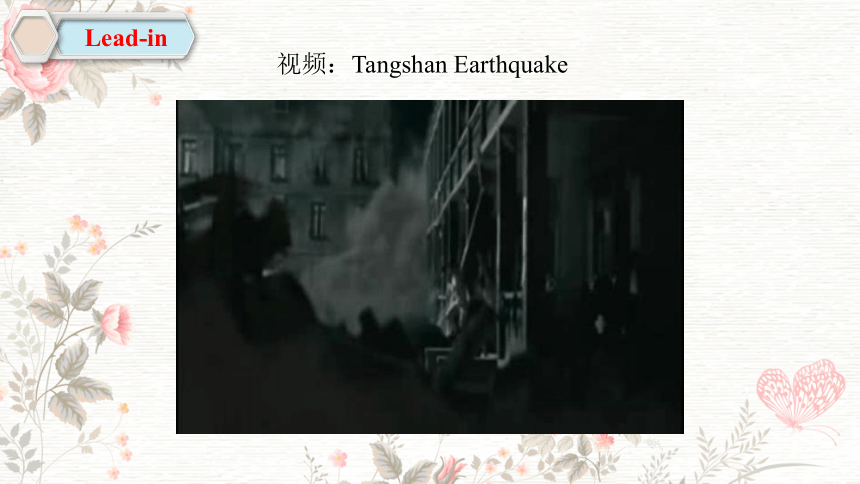
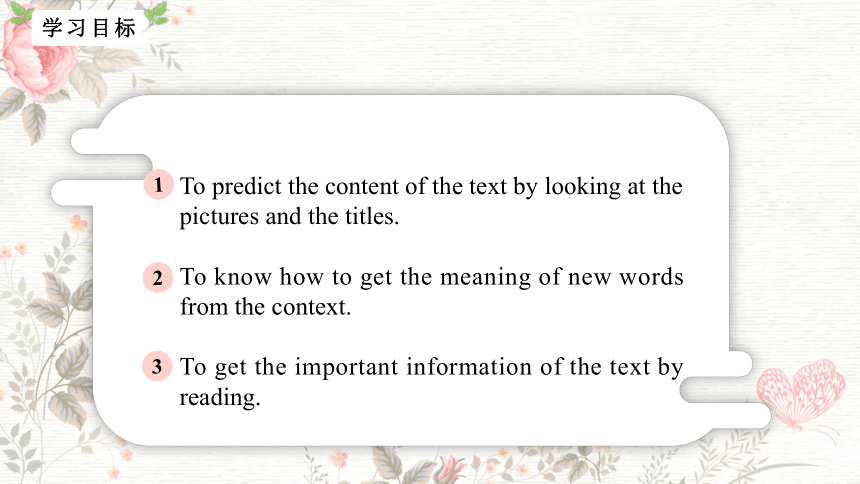
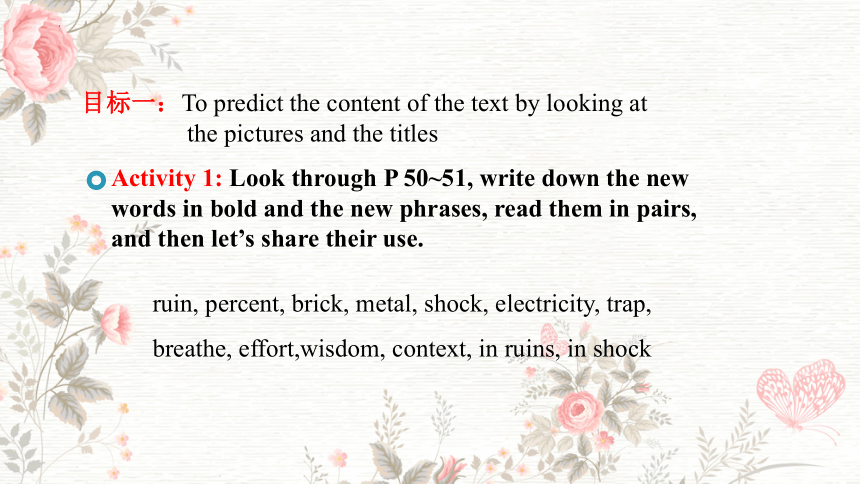
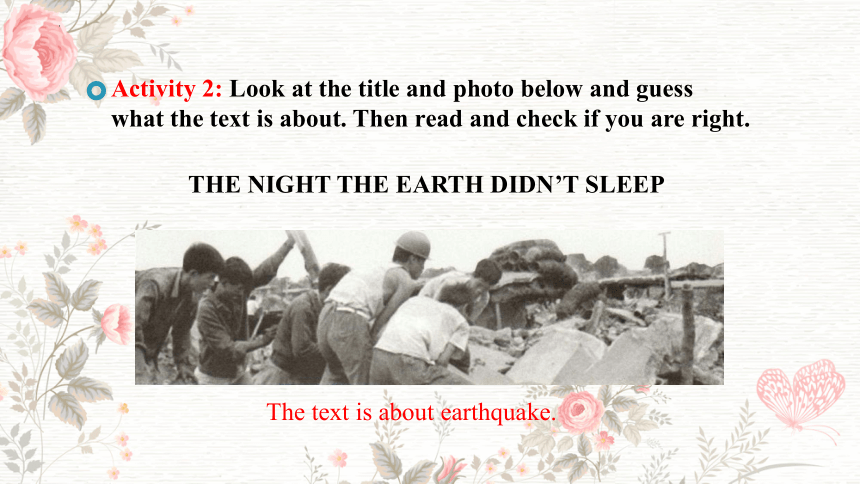
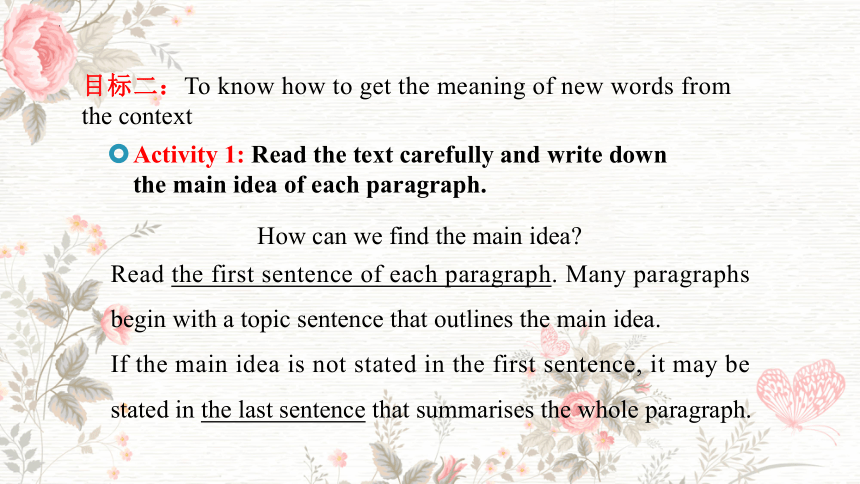

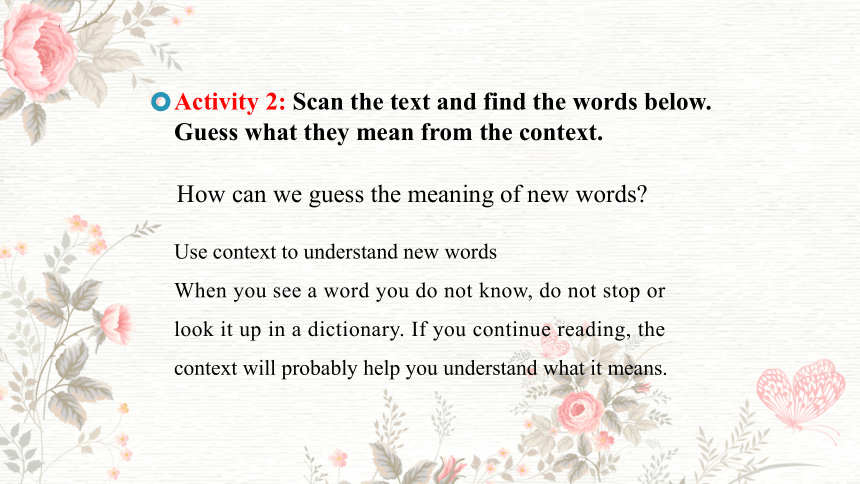
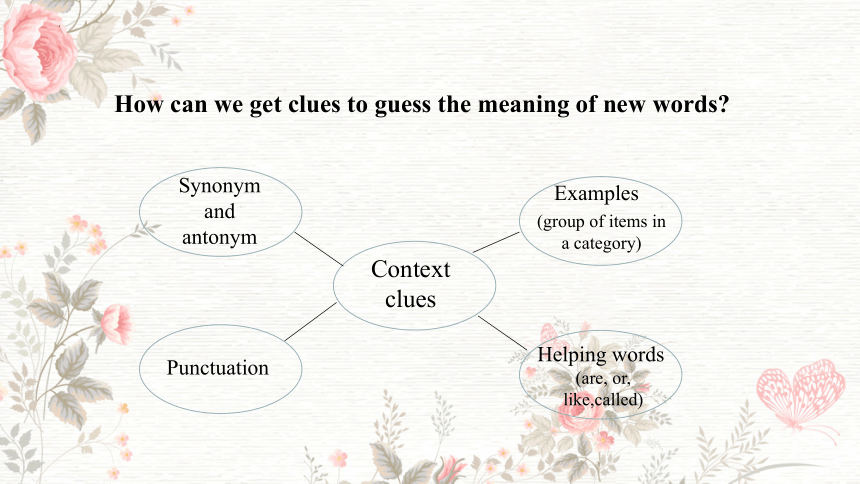
文档简介
(共24张PPT)
人教必修一
Unit 4
Reading and Thinking
Describe a natural disaster
( I )
教学目
Lead-in
视频:Tangshan Earthquake
1
2
To predict the content of the text by looking at the pictures and the titles.
To know how to get the meaning of new words from the context.
To get the important information of the text by reading.
3
目标一:To predict the content of the text by looking at
the pictures and the titles
Activity 1: Look through P 50~51, write down the new words in bold and the new phrases, read them in pairs, and then let’s share their use.
ruin, percent, brick, metal, shock, electricity, trap, breathe, effort,wisdom, context, in ruins, in shock
Activity 2: Look at the title and photo below and guess what the text is about. Then read and check if you are right.
THE NIGHT THE EARTH DIDN’T SLEEP
The text is about earthquake.
目标二:To know how to get the meaning of new words from the context
Activity 1: Read the text carefully and write down the main idea of each paragraph.
How can we find the main idea
Read the first sentence of each paragraph. Many paragraphs begin with a topic sentence that outlines the main idea.
If the main idea is not stated in the first sentence, it may be stated in the last sentence that summarises the whole paragraph.
Paragraph 1: __________________________________________
Paragraph 2: __________________________________________
Paragraph 3: __________________________________________
Paragraph 4: __________________________________________
Paragraph 5: __________________________________________
Warning signs before the earthquake.
The happening of the big earthquake.
The immediate effects of the earthquake.
The rescue work.
The revival of the city.
Activity 2: Scan the text and find the words below.
Guess what they mean from the context.
How can we guess the meaning of new words
Use context to understand new words
When you see a word you do not know, do not stop or look it up in a dictionary. If you continue reading, the context will probably help you understand what it means.
How can we get clues to guess the meaning of new words
Synonym and antonym
Examples
(group of items in a category)
Context
clues
Punctuation
Helping words
(are, or, like,called)
ruin brick trap bury
1.Context clues: A huge crack, ..., cut across houses, roads, and waterways. Hard hills of rock became rivers of dirt. In less than one minute, a large city lay in ruins.
2.Context clues: Bricks covered the ground like red autumn leaves, but no wind could blow them away.
3.Context clues: Soon after the quakes, the army sent 150,000 soldiers to Tangshan to dig out those who were trapped and to bury the dead.
1.“Ruin” means the parts of a building that remain after it has been destroyed.
2.“Brick” means something used for building walls.
3.“Trap” means someone is in a dangerous place that they want to get out of but cannot.
“Bury” means covering with earth to deal with the dead.
Answers:
人教必修一
Unit 4
Reading and Thinking
Describe a natural disaster
(II)
Activity 1: Read the text and try to figure out how many parts the text can be divided and what they are.
目标三:To get the important information of the text by reading.
________the earthquake
________the earthquake
________the earthquake
signs
destroy
rescue and revival
Part 1
Para.1
Part 2
Para.2, 3
Part 3
Para.4, 5
before
during
after
Activity 2:Careful reading
Read the text quickly and try to get some details of the text.
1.Details about Para.1 ---- the signs before the earthquake.
What happened Strange things
wells
animals
Light and sound
Water rose and fell, cracks
Chickens and pigs didn’t eat ;
Mice ran out; Fish jumped out.
Could be seen and heard
2.Fill in the data (数据) in para 2—3 and answer the question.
1) _________of the nation felt the earthquake.
2) A huge crack that was____kilometres long and _____ metres wide cut across houses
3) In less than ____ minute, a large city lay in ruins.
4)__________of the people were died or injured during the earthquake.
5) The number of people who were killed or injured reached more than__________.
6) _____of its factories and buildings, _____ of its homes and all of the city's hospitals were gone.
One third
8
30
1
Two thirds
400,000
75%
90%
Why did the writer use so many numbers
To show the earthquake was very serious and it caused a lot of damage to people and the city.
3.Details about Para.4—5 --- rescue and revival after the earthquake.
(1) How did the city begin to breathe
(2) How can you tell Tangshan started to revive again
(1)
The army sent 150,000 soldiers there
Doctors and nurses came to provide medical care.
Workers built shelters for survivors.
Water and food were brought into the city.
(2)
With strong support from the government and the tireless efforts of the city's people, a new Tangshan was built upon the earthquake ruins. The city became a home to more than seven million people, with great improvements in transportation, industry and environment
Answers:
Activity 3: Read the sentences describing what happened after a huge plete the sentences with the correct forms of the new words and phrases from the text.
1.The huge earthquake left nearly the whole city __________.
2.Everyone was ________, thinking the world must be coming to an end.
3.Millions of people were left without water, food, or __________.
4.Soldiers and volunteers worked as hard as they could to pull away _______ and rocks, and rescue those who were ________ under the ruins.
5.Some were found alive, though they were suffering from terrible injures, but others had already stopped _________ when they were discovered.
6.A few buildings were still standing, but people were afraid to use them as shelters, worrying they would be _________ if the buildings fell.
in ruins
in shock
electricity
bricks
buried
breathing
trapped
Activity 4: Read the text again and answer the questions.
1.What were some of the strange things happening before the earthquake
Do you think they were warning signs Why or why not
2.What does the writer mean by “Slowly, the city began to breathe again”
3.What kind of help do you think people who have suffered an earthquake need
Answers:
1.(1) Deep cracks in the well walls; Water in it rose and fell; Some smelly gas came out of it; Chickens and pigs were too nervous to eat; Dogs refused to go inside buildings; mice ran out of the fields; Fish jumped out of the water; Bright lights were seen in the sky.
(2) Yes, because animals can sense the incoming quakes before human can sense them.
No, because earthquakes don’t always behave in a consistent way. Some signs occur at different times, whereas sometimes those signs do not occur at all.
2.The Tangshan city began to get help and there was hope to recover.
3.a.They need quick access to basic things such as water and food, because they cannot get them easily.
b.They also need medical care, not just for injuries, but to protect against disease and other problems that happen after the earthquake.
c.They need psychological care and help.
Activity 5: Work in groups. Discuss the questions.
1. What do you think helped in the revival of Tangshan city
2. What other cities or towns have gone through similar changes
What lessons can we learn from these events
Answers:
1. (1) Strong support form the government;
(2) Tireless efforts of city’s people;
(3) People’s spirit of unity and positive attitude;
...
2.Wenchuan, China.
People should strengthen unity in the times of disaster;
People should learn some survival skills and train themselves on what they need to ensure their safety during the quake; ...
1.Can you retell the content of the text
2.Is there anything we can do to survive in a terrible disaster
人教必修一
Unit 4
Reading and Thinking
Describe a natural disaster
( I )
教学目
Lead-in
视频:Tangshan Earthquake
1
2
To predict the content of the text by looking at the pictures and the titles.
To know how to get the meaning of new words from the context.
To get the important information of the text by reading.
3
目标一:To predict the content of the text by looking at
the pictures and the titles
Activity 1: Look through P 50~51, write down the new words in bold and the new phrases, read them in pairs, and then let’s share their use.
ruin, percent, brick, metal, shock, electricity, trap, breathe, effort,wisdom, context, in ruins, in shock
Activity 2: Look at the title and photo below and guess what the text is about. Then read and check if you are right.
THE NIGHT THE EARTH DIDN’T SLEEP
The text is about earthquake.
目标二:To know how to get the meaning of new words from the context
Activity 1: Read the text carefully and write down the main idea of each paragraph.
How can we find the main idea
Read the first sentence of each paragraph. Many paragraphs begin with a topic sentence that outlines the main idea.
If the main idea is not stated in the first sentence, it may be stated in the last sentence that summarises the whole paragraph.
Paragraph 1: __________________________________________
Paragraph 2: __________________________________________
Paragraph 3: __________________________________________
Paragraph 4: __________________________________________
Paragraph 5: __________________________________________
Warning signs before the earthquake.
The happening of the big earthquake.
The immediate effects of the earthquake.
The rescue work.
The revival of the city.
Activity 2: Scan the text and find the words below.
Guess what they mean from the context.
How can we guess the meaning of new words
Use context to understand new words
When you see a word you do not know, do not stop or look it up in a dictionary. If you continue reading, the context will probably help you understand what it means.
How can we get clues to guess the meaning of new words
Synonym and antonym
Examples
(group of items in a category)
Context
clues
Punctuation
Helping words
(are, or, like,called)
ruin brick trap bury
1.Context clues: A huge crack, ..., cut across houses, roads, and waterways. Hard hills of rock became rivers of dirt. In less than one minute, a large city lay in ruins.
2.Context clues: Bricks covered the ground like red autumn leaves, but no wind could blow them away.
3.Context clues: Soon after the quakes, the army sent 150,000 soldiers to Tangshan to dig out those who were trapped and to bury the dead.
1.“Ruin” means the parts of a building that remain after it has been destroyed.
2.“Brick” means something used for building walls.
3.“Trap” means someone is in a dangerous place that they want to get out of but cannot.
“Bury” means covering with earth to deal with the dead.
Answers:
人教必修一
Unit 4
Reading and Thinking
Describe a natural disaster
(II)
Activity 1: Read the text and try to figure out how many parts the text can be divided and what they are.
目标三:To get the important information of the text by reading.
________the earthquake
________the earthquake
________the earthquake
signs
destroy
rescue and revival
Part 1
Para.1
Part 2
Para.2, 3
Part 3
Para.4, 5
before
during
after
Activity 2:Careful reading
Read the text quickly and try to get some details of the text.
1.Details about Para.1 ---- the signs before the earthquake.
What happened Strange things
wells
animals
Light and sound
Water rose and fell, cracks
Chickens and pigs didn’t eat ;
Mice ran out; Fish jumped out.
Could be seen and heard
2.Fill in the data (数据) in para 2—3 and answer the question.
1) _________of the nation felt the earthquake.
2) A huge crack that was____kilometres long and _____ metres wide cut across houses
3) In less than ____ minute, a large city lay in ruins.
4)__________of the people were died or injured during the earthquake.
5) The number of people who were killed or injured reached more than__________.
6) _____of its factories and buildings, _____ of its homes and all of the city's hospitals were gone.
One third
8
30
1
Two thirds
400,000
75%
90%
Why did the writer use so many numbers
To show the earthquake was very serious and it caused a lot of damage to people and the city.
3.Details about Para.4—5 --- rescue and revival after the earthquake.
(1) How did the city begin to breathe
(2) How can you tell Tangshan started to revive again
(1)
The army sent 150,000 soldiers there
Doctors and nurses came to provide medical care.
Workers built shelters for survivors.
Water and food were brought into the city.
(2)
With strong support from the government and the tireless efforts of the city's people, a new Tangshan was built upon the earthquake ruins. The city became a home to more than seven million people, with great improvements in transportation, industry and environment
Answers:
Activity 3: Read the sentences describing what happened after a huge plete the sentences with the correct forms of the new words and phrases from the text.
1.The huge earthquake left nearly the whole city __________.
2.Everyone was ________, thinking the world must be coming to an end.
3.Millions of people were left without water, food, or __________.
4.Soldiers and volunteers worked as hard as they could to pull away _______ and rocks, and rescue those who were ________ under the ruins.
5.Some were found alive, though they were suffering from terrible injures, but others had already stopped _________ when they were discovered.
6.A few buildings were still standing, but people were afraid to use them as shelters, worrying they would be _________ if the buildings fell.
in ruins
in shock
electricity
bricks
buried
breathing
trapped
Activity 4: Read the text again and answer the questions.
1.What were some of the strange things happening before the earthquake
Do you think they were warning signs Why or why not
2.What does the writer mean by “Slowly, the city began to breathe again”
3.What kind of help do you think people who have suffered an earthquake need
Answers:
1.(1) Deep cracks in the well walls; Water in it rose and fell; Some smelly gas came out of it; Chickens and pigs were too nervous to eat; Dogs refused to go inside buildings; mice ran out of the fields; Fish jumped out of the water; Bright lights were seen in the sky.
(2) Yes, because animals can sense the incoming quakes before human can sense them.
No, because earthquakes don’t always behave in a consistent way. Some signs occur at different times, whereas sometimes those signs do not occur at all.
2.The Tangshan city began to get help and there was hope to recover.
3.a.They need quick access to basic things such as water and food, because they cannot get them easily.
b.They also need medical care, not just for injuries, but to protect against disease and other problems that happen after the earthquake.
c.They need psychological care and help.
Activity 5: Work in groups. Discuss the questions.
1. What do you think helped in the revival of Tangshan city
2. What other cities or towns have gone through similar changes
What lessons can we learn from these events
Answers:
1. (1) Strong support form the government;
(2) Tireless efforts of city’s people;
(3) People’s spirit of unity and positive attitude;
...
2.Wenchuan, China.
People should strengthen unity in the times of disaster;
People should learn some survival skills and train themselves on what they need to ensure their safety during the quake; ...
1.Can you retell the content of the text
2.Is there anything we can do to survive in a terrible disaster
